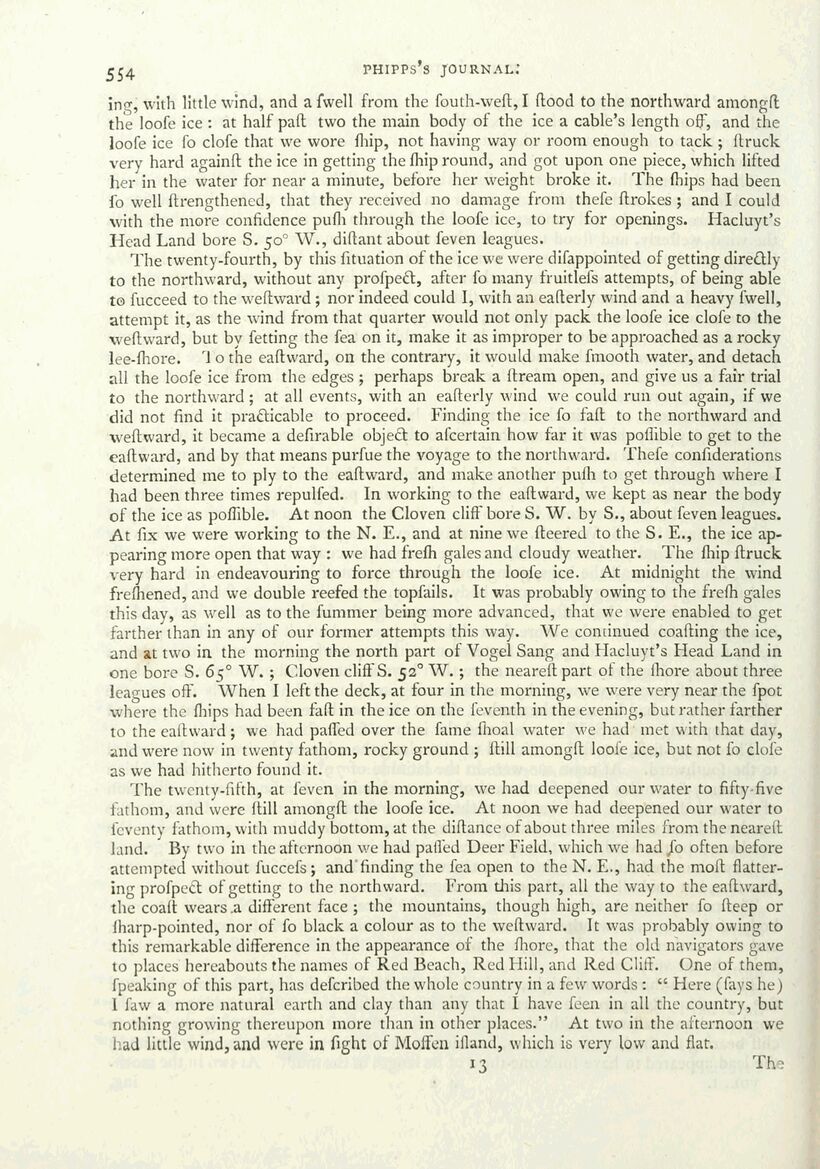
Full resolution (JPEG) - On this page / på denna sida - Pages ...

<< prev. page << föreg. sida << >> nästa sida >> next page >>
Below is the raw OCR text
from the above scanned image.
Do you see an error? Proofread the page now!
Här nedan syns maskintolkade texten från faksimilbilden ovan.
Ser du något fel? Korrekturläs sidan nu!
This page has never been proofread. / Denna sida har aldrig korrekturlästs.
554 PHIPPS’$ JOURNAL:
ing, with little wind, and a fwell from the fouth-weft, I ftood to the northward amongit
the loofe ice: at half paft two the main body of the ice a cable’s length off, and the
loofe ice fo clofe that we wore fhip, not having way or room enough to tack; {truck
very hard againft the ice in getting the fhip round, and got upon one piece, which lifted
her in the water for near a minute, before her weight broke it. The fhips had been
fo well ftrengthened, that they received no damage from thefe ftrokes ; and I could
with the more confidence pufh through the loofe ice, to try for openings. Hacluyt’s
Head Land bore S. 50° W., diftant about feven leagues.
The twenty-fourth, by this fituation of the ice we were difappointed of getting direaly
to the northward, without any profpect, after fo many fruitlefs attempts, of being able
to fucceed to the weftward ; nor indeed could I, with an eafterly wind and a heavy fwell,
attempt it, as the wind from that quarter would not only pack the loofe ice clofe to the
weftward, but by fetting the fea on it, make it as improper to be approached as a rocky
lee-fhore. ‘lothe eaftward, on the contrary, it would make fmooth water, and detach
all the loofe ice from the edges; perhaps break a {tream open, and give us a fair trial
to the northward; at all events, with an eafterly wind we could run out again, if we
did not find it pra€ticable to proceed. Finding the ice fo faft to the northward and
weftward, it became a defirable object to afcertain how far it was poflible to get to the
eaftward, and by that means purfue the voyage to the northward. ‘Thefe confiderations
determined me to ply to the eaftward, and make another puth to get through where I
had been three times repulfed. In working to the eaftward, we kept as near the body
of the ice as poflible. Atnoon the Cloven cliff bore S. W. by S., about feven leagues.
At fix we were working to the N. E., and at nine we fteered to the S. E., the ice ap-
pearing more open that way: we had frefh galesand cloudy weather. he fhip ftruck
very hard in endeavouring to force through the loofe ice. At midnight the wind
frefhened, and we double reefed the topfails. It was probably owing to the freth gales
this day, as well as to the fummer being more advanced, that we were enabled to get
farther than in any of our former attempts this way. We conunued coafting the ice,
and at two in the morning the north part of Vogel Sang and Hacluyt’s Head Land in
one bore S. 65° W.; Cloven cliff S. 52° W.; the neare(ft part of the fhore about three
leagues off. When I left the deck, at four in the morning, we were very near the {pot
where the fhips had been faft in the ice on the feventh in the evening, but rather farther
to the ealtward; we had paffed over the fame fhoal water we had’ met with that day,
and were now in twenty fathom, rocky ground ; {till amongft loofe ice, but not fo clofe
as we had hitherto found it.
The twenty-fifth, at feven in the morning, we had deepened our water to fifty-five
fathom, and were {till amongft the loofe ice. At noon we had deepened our water to
feventy fathom, with muddy bottom, at the diftance of about three miles from the nearett
land. By two in the afternoon we had pafled Deer Field, which we had fo often before
attempted without fuccefs; and finding the fea open to the N. E., had the moft flatter-
ing profpect of getting to the northward. rom this part, all the way to the eaftward,
the coaft wears.a different face ; the mountains, though high, are neither fo fteep or
fharp-pointed, nor of fo black a colour as to the weftward. It was probably owing to
this remarkable difference in the appearance of the fhore, that the old navigators gave
to places hereabouts the names of Red Beach, Red Hill, and Red Cliff. One of them,
{peaking of this part, has defcribed the whole country in a few words: ‘ Here (fays he)
{ faw a more natural earth and clay than any that I have {een in all the country, but
nothing growing thereupon more than in other places.” At two in the afternoon we
had little wind, and were in fight of Moffen ifland, which is very low and flat.
13 The
<< prev. page << föreg. sida << >> nästa sida >> next page >>